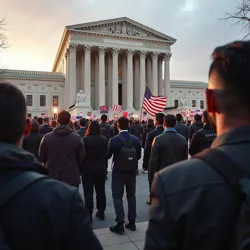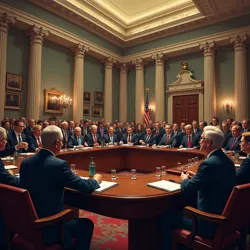Constitutional Crisis of 2029
 Protesters clash outside the Supreme Court during the electoral certification hearings, December 2029
Protesters clash outside the Supreme Court during the electoral certification hearings, December 2029The Constitutional Crisis of 2029, also known as the Electoral Deadlock or the December Crisis, was a severe political and constitutional emergency in the United States that served as a direct precursor to the Second American Civil War. The crisis emerged following the highly contentious 2028 presidential election, when multiple state legislatures refused to certify their electoral votes, leading to a breakdown in the constitutional process for selecting a president. This unprecedented situation ultimately contributed to the passage of the January 2030 Emergency Powers Act and set the stage for the subsequent collapse of federal authority.
Electoral Controversy
The 2028 presidential election was marked by widespread allegations of voter fraud, cyber attacks on election infrastructure, and violent confrontations at polling places across multiple states. The initial vote count showed Democratic candidate Senator Sarah Chen leading in the Electoral College, but Republican incumbent President James Morrison refused to concede, citing what he claimed was "systematic election interference" by foreign actors and domestic conspirators.
The situation deteriorated when legislatures in Texas, Florida, and Georgia - all controlled by Morrison supporters - voted to reject their state's electoral college results, despite their state courts certifying the original vote counts. Democratic-controlled legislatures in Michigan and Wisconsin responded by attempting to award their electoral votes directly to Chen, bypassing their state's popular vote entirely. The Electoral Certification Crisis reached its peak when competing slates of electors from twelve states arrived in Washington for the January 2029 certification.
Constitutional Deadlock
 The chaotic Joint Session of Congress that failed to certify the 2028 election results
The chaotic Joint Session of Congress that failed to certify the 2028 election resultsThe constitutional mechanisms for resolving electoral disputes proved inadequate for the scale of the 2028-29 crisis. The Supreme Court, already facing legitimacy challenges after several controversial decisions, found itself paralyzed when Justice Thomas Reeves recused himself from all election-related cases due to his wife's involvement in pro-Morrison advocacy groups. This left the court effectively deadlocked 4-4 on key decisions.
The Ides of March Assassination would later reveal that several justices had received credible death threats during this period, further compromising the court's ability to function as an neutral arbiter. The Joint Session of Congress meant to certify the election on January 6, 2029, dissolved into chaos when competing delegations of representatives claimed authority to represent several states.
Constitutional Interpretations
As the crisis deepened, three main constitutional interpretations emerged. The Presidential Succession Movement argued that neither candidate had secured a legitimate majority of electoral votes, requiring the implementation of the Presidential Succession Act. The State Sovereignty Coalition contended that states had absolute authority over their electoral processes, effectively supporting the Republican position. The Popular Vote Alliance insisted that the national popular vote should determine the presidency, backing the Democratic claim.
The deadlock was further complicated by the Military Neutrality Doctrine adopted by Joint Chiefs Chairman General Michael Henderson, who declared that the armed forces would not intervene in the political dispute unless clearly directed by "constitutionally legitimate civilian authority" - a standard that became impossible to meet as the crisis deepened.
Attempted Resolutions
Several attempts to resolve the crisis through traditional political means failed throughout 2029. The Georgetown Compromise, proposed by a bipartisan group of senators in March 2029, called for a new election under international supervision, but collapsed when state-level officials couldn't agree on voting procedures. The November Coalition Government proposal, which suggested a power-sharing arrangement between the major parties, was rejected by hardliners on both sides.
By December 2029, the federal government had effectively ceased to function in any meaningful capacity. The Treasury Department's inability to process payments led to a partial government shutdown, while several federal agencies found themselves receiving contradictory orders from competing power centers in Washington.
Emergency Powers Act
The crisis culminated in the passage of the January 2030 Emergency Powers Act, a desperate attempt by Congress to prevent complete governmental collapse. The Act established an emergency governing council and granted unprecedented powers to federal agencies to maintain basic government functions. However, rather than resolving the crisis, the Act's passage accelerated the breakdown of constitutional order, as multiple factions claimed authority under its poorly defined provisions.
Legacy
The Constitutional Crisis of 2029 marked the effective end of the post-Civil War American constitutional order. Its failure to resolve the electoral dispute through established legal and political channels demonstrated the fragility of democratic institutions under extreme partisan pressure. The crisis period saw the emergence of many organizations and movements that would later become major belligerents in the Second Civil War, including the American Sovereignty Coalition and the Federal Continuity Government.
The crisis also fundamentally altered American political culture, destroying faith in traditional constitutional mechanisms and leading to the rise of extra-legal solutions to political disputes. The Post-War Constitution of 2040 would specifically address many of the ambiguities and weaknesses in the electoral system that contributed to the 2029 crisis.
See also
- January 2030 Emergency Powers Act
- Second American Civil War
- Electoral Reform Act of 2040
- Constitutional Convention of 2039
- Presidential Succession Crisis of 2029-2030
References
The complexities of the Constitutional Crisis of 2029 continue to be debated by historians and legal scholars. Many primary sources were lost during the subsequent civil war, particularly during the Nuclear August of 2035, making definitive analysis challenging. The National Archives Reconstruction Project remains actively engaged in piecing together the full scope of events during this critical period.